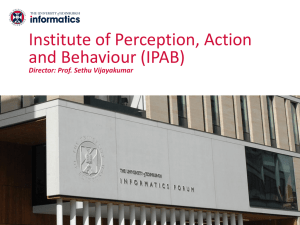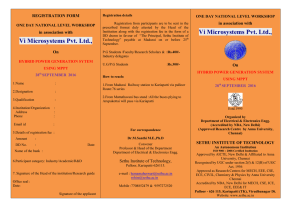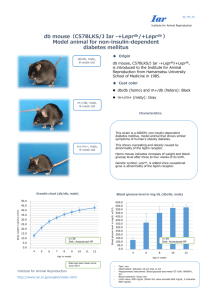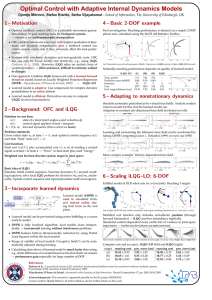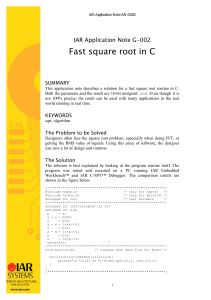Open loop vs Closed Loop Steady State vs Transient Response
advertisement
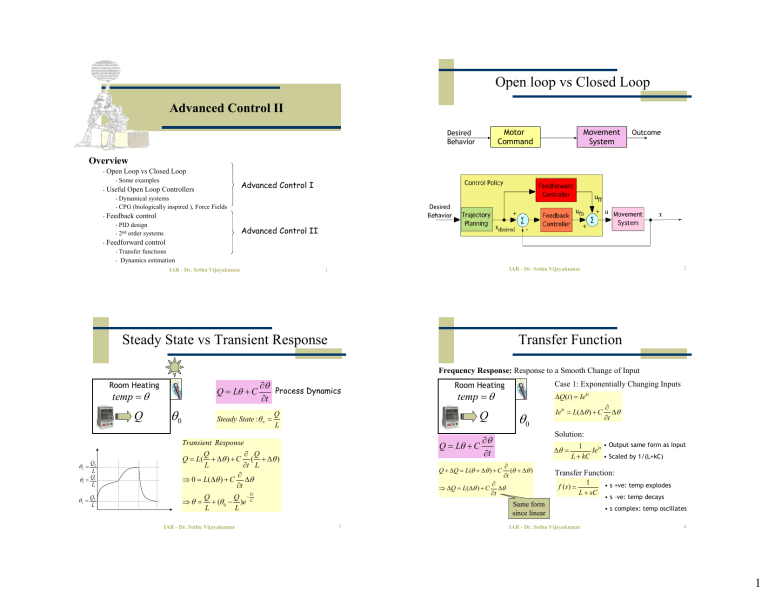
Open loop vs Closed Loop Advanced Control II Motor Command Desired Behavior Movement System Outcome Overview • Open Loop vs Closed Loop • Useful Open Loop Controllers • Some examples Advanced Control I Dynamical systems • CPG (biologically inspired ), Force Fields • • Feedback control • • • PID design 2nd order systems Advanced Control II Feedforward control • • Transfer functions Dynamics estimation 1 IAR - Dr. Sethu Vijayakumar 2 IAR - Dr. Sethu Vijayakumar Steady State vs Transient Response Transfer Function Frequency Response: Response to a Smooth Change of Input Room Heating Q = Lθ + C temp = θ Q Q2 L Q θ1 = 1 L θ2 = Q θ3 = 3 L θ0 ∂θ Process Dynamics ∂t Steady State : θ ∞ = Q = Lθ + C Transient Response Q ∂ Q Q = L( + ∆θ ) + C ( + ∆θ ) L ∂t L ∂ ⇒ 0 = L(∆θ ) + C ∆θ ∂t Lt Q Q − ⇒ θ = + (θ 0 − )e C L L IAR - Dr. Sethu Vijayakumar temp = θ ∆Q(t ) = Iekt θ0 Q Q L Case 1: Exponentially Changing Inputs Room Heating ∆θ = ∂ (θ + ∆θ ) ∂t ∂ ⇒ ∆Q = L(∆θ ) + C ∆θ ∂t • Output same form as Input 1 Iekt L + kC • Scaled by 1/(L+kC) Transfer Function: f (s) = 1 L + sC Same form since linear 3 ∂ ∆θ ∂t Solution: ∂θ ∂t Q + ∆Q = L(θ + ∆θ ) + C Iekt = L(∆θ ) + C IAR - Dr. Sethu Vijayakumar • s +ve: temp explodes • s –ve: temp decays • s complex: temp oscillates 4 1 Transfer Function (cont’d) Case 2: Exponentially Changing Inputs ∆Q(t ) = I cos ωt Room Heating temp = θ I cos ωt = L(∆θ ) + C Q Q = Lθ + C ⇒ ∆Q = L(∆θ ) + C Room Heating Q = L(θ − θ 0 ) + C temp = θ ∂ ∆θ ∂t θ0 Q Control Law : ωC ∆θ = 2 cos ωt + 2 sin ωt L + ω 2C 2 L + ω 2C 2 L ∂ (θ + ∆θ ) ∂t ∂ ∆θ ∂t or ∆θ = Feedback control changes dynamics 1 Ieiωt L + iωC Q = k ( θt − θ ) Steady State :θ ∞ = Time Constant : Transfer Function: f (ω ) = 1 L + iωC ∂θ ∂t k = gain constant Solution: ∂θ ∂t Q + ∆Q = L(θ + ∆θ ) + C Feedback Control: Proportional Error k θt Lθ0 + ≠ θt L+k L+k τ= C (L+k) • High Gain → Small Error, Fast Response, Instability • Steady State Error • Time Lag IAR - Dr. Sethu Vijayakumar 5 IAR - Dr. Sethu Vijayakumar Eliminating Steady State Error Use Feedforward Scheme PID control Q = k (θ t − θ ) + L(θt − θ 0 ) Q = K p ⋅ e + K i ⋅ ∫ e ⋅ ∂t + K d ⋅ where e = (θ − θ t ) Needs Dynamics Model (L) Error persists if L is inaccurate e Change Control Law Q = k p (θt − θ ) + ki ∫ (θt − θ )dt e ∂e ∂t ∂e ∂t Without derivative action e ∂e ∂t Proportional Integral Controller Integral controller eliminates steady-state error No dynamic model needed Don’t need high kp gains Overshoot /ringing problems Choice of kp and ki is tricky IAR - Dr. Sethu Vijayakumar 6 t • With derivative action, the controller output is proportional to the rate of change of the measurement or error: braking effect. • Adds damping Æ brakes the dynamics: reduces overshoot and tends to reduce the settling time • Problem: if too large, will slow down the dynamics, and increase the rising and settling time 7 IAR - Dr. Sethu Vijayakumar 8 2 Second Order Process Proportional Error Law More complex behavior Similar analysis tools Control Input x Motor Dynamics Car Position 0 = k p + s + τs ⇒s=− 9 k p e + kd e& x x feedback x& Transient Analysis Solution • Choose k_d to set time constant 0 = k p + ( 1 + kd )s + τs • Choose k_p for critical damping ⇒s=− 2 ( 1 + kd )2 − 4k p τ 1 + kd ± 2τ 2τ IAR - Dr. Sethu Vijayakumar Under-damped Over-damped 2 1 − 4k p τ 1 ± 2τ 2τ Critically Damped kp < 1 4τ kp = 1 4τ Ringing kp > 1 4τ 10 Feedback: Pros and Cons car dx d2x +τ 2 dt dt Second Order Behavior IAR - Dr. Sethu Vijayakumar Proportional Derivative Error Law xt x feedback Transient Analysis Solution dx d 2x +τ 2 dt dt IAR - Dr. Sethu Vijayakumar controller dx d2x +τ 2 dt dt k p ( xt − x ) x β car controller xt 11 + Alters Process Dynamics + Insensitive (relatively) to model errors + Insensitive to disturbances - (P) Steady State Error (P-I) Overshoot (P-D) Gain Limitations, Noise Amplification - Assumes instant feedback - Limited by time constant in feedback path Can and Do use Open loop with Feedforward + Fast response + Often Simple to do - Need good process model (dynamics) …Learn It (details in MLSC course) IAR - Dr. Sethu Vijayakumar 12 3
